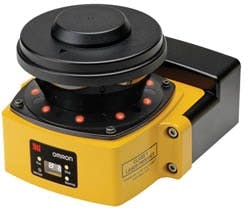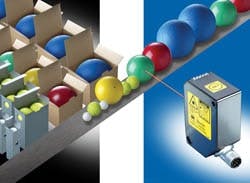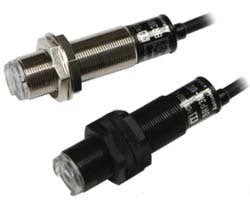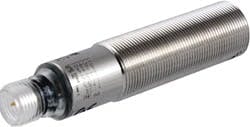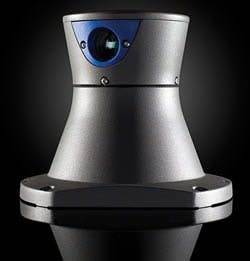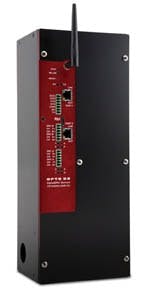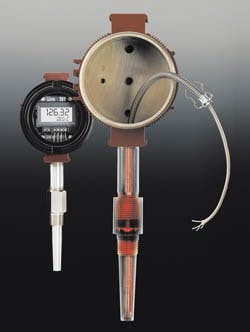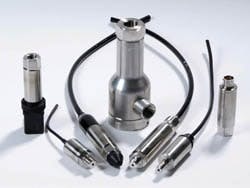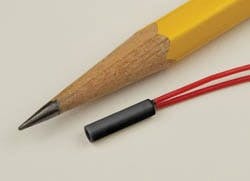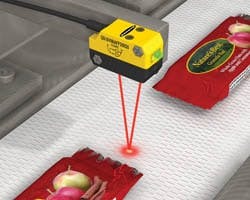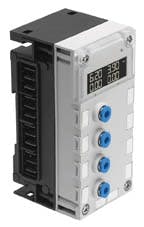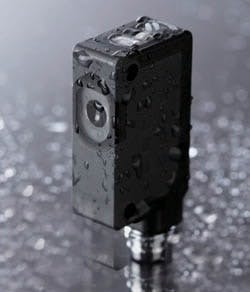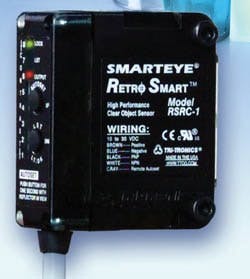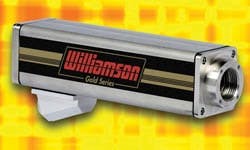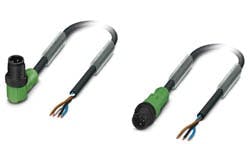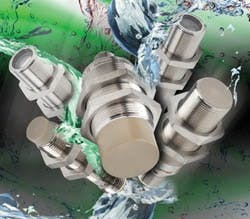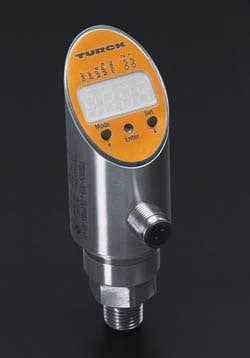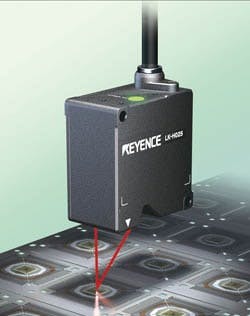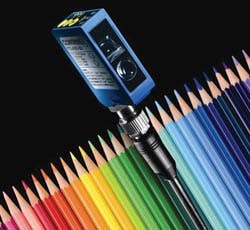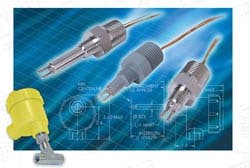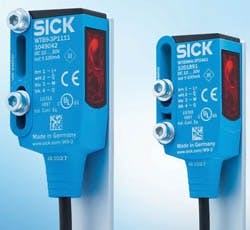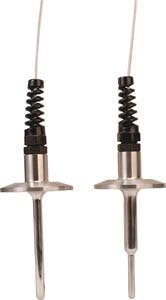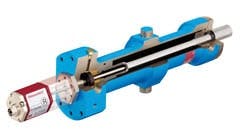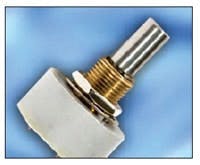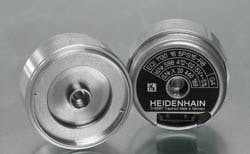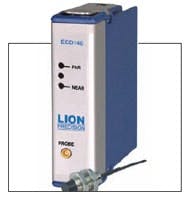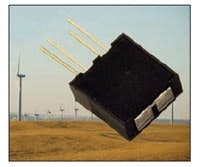Turning to capture growing markets with harsh environments, manufacturers are creating a new breed of sensor with the operating temperatures, materials and functionality that make them more rugged. "As automation has evolved from the automotive industry to others such as food and beverage, solar panel production, wind power generation and more, a new class of sensors designed to handle the harsh environments is required," says Howard Minnick, president of ASI.
Although increasing ruggedness is one characteristic — along with longer range and smaller packages — for which sensor customers continually look for improvement, there are certain applications that require more from the sensor.
The burgeoning food and beverage industry, for example, is attracting more attention from suppliers. "There is a trend to develop products that are more designed for the environmental requirements of that industry," says Craig Brockman, marketing manager, proximity sensors, for Rockwell Automation. "In the past it's been trying to take existing products and make them work in that industry." These days, sensor developers look more at what the unique requirements are for the food and beverage industry.
Where food comes in direct contact with machines, for example, the need to clean that equipment to make sure no bacteria is allowed to grow on it presents some unique requirements. "Sensor innovations have been driven by many industries, including food and beverage, that require wash downs to maintain a sterile environment," says Melissa Schumann, product manager at Turck.
Those wash downs are done at high pressure and with hot water, making it necessary for sensors to be rated to IP69K standards (the "9" classifying protection from close-range, high-pressure spray downs; and the "K" signifying high-temperature water). But there's more to it than that, including caustic chemicals and bacteria working their way into small spaces.
The hot water is often mixed with cleaning chemicals, making stainless steel 316 a popular material for sensors in the food industry. "A lot of sensors are made out of nickel-plated brass or other materials that maybe over time might rust, or if they're made out of plastic they may not hold up to the caustic cleaning chemicals," Brockman says.
Sensors in the food and beverage industry also require wider operating temperatures, not only to stand up to the high-temperature wash downs, Brockman says, but also because they may be used in a freezing tunnel or by an oven. Most standard sensors have an operating temperature range of -25 to 70 °C, but sensors in this industry require -40 to 80 °C or higher. ASI has a range of rugged sensors that can operate at temperatures as low as -60 °C and as high as 250 °C, Minnick notes.
Finally, manufacturers are also looking for new ways to avoid food and bacteria traps within the sensors. A standard inductive sensor, for example, might have threading on the barrel, which could retain food regardless of how well the machine is cleaned. So suppliers are coming up with new ways to mount the sensors to avoid the threading, Brockman notes. Rockwell has also come up with a new way to program its photoelectric sensors that does away with external pots or pushbuttons to further avoid food traps.
All the innovations lead to increased uptime, important not because the sensors are expensive to replace, but because lost manufacturing time is costly. "The user benefit is clear," Schumann says. "The sensor survives in the wash-down environment, leading to less downtime and fewer maintenance calls."
Changes made on behalf of the food and beverage, or pharmaceutical industries can be advantageous in other industries as well, Brockman points out. They could be of benefit in the mobile industry, including off-road equipment, agricultural equipment and construction equipment, which all use sensors. "If you're making a crane, you don't know if that crane's going to end up in the desert or Arctic Circle," he says. "Having housing that can withstand wash down or being exposed to outdoor elements and not corrode is a benefit as well."
Versatile Scanner
OS32C Type 3 safety laser scanner with 5 W power consumption has flexible and configurable detection zones, system monitoring over LAN via integrated Ethernet port, and a 270° detection angle so a single scanner can provide presence detection, including two warning zones and one safety zone, on two sides of a machine.
Omron STI
800/479-3658
www.sti.com
OADM 250 optical laser distance sensor detects target objects, regardless of surface properties or color at distances of 0.2–4 m with response times below 10 ms, 1.2 mm resolutions, and ±5 mm repeat accuracy, even on moving targets. It has an aluminum housing, washable glass front optics, and IP67 certification.
Baumer
860/620-6369
www.baumer.com
BR Series cylindrical, retroreflective photoelectric sensors detect up to 20 m, with response time below 1 ms, reverse power polarity and short-circuit/overcurrent protection circuit, excellent heat-resistance performance with glass lens (BR4M), and IP66 protection.
Autonics
847/680-8160
www.autonics.com
Photoswitch 42CS inductive sensor has smooth or threaded 18 mm 316L stainless steel housing with a hard plastic lens for an operating range of -25 to 85 °C. Ferromagnetic teach feature minimizes the possibility of water ingress associated with pushbutton or potentiometer adjustment. It has polarized retro-reflective, diffuse, transmitted beam, clear-object detection and background suppression sensing modes.
Rockwell Automation
440/646-3434
www.ab.com/sensors
LS5 Navigator is designed to withstand -30 to 50 °C, 95% relative humidity, and vibrations and shocks. It has an optics system and is adaptable to different types of communication. It works with AutoSurveyor, a software tool for determination of reflector coordinates, and is available in an outdoor/indoor-use and an indoor-use only version.
Kollmorgen
540/633-3545
www.kollmorgen.com
OptoEMU Sensor is a web-enabled energy monitoring and data acquisition hardware appliance that lets commercial and industrial customers acquire power consumption data from facility systems, machines, equipment and metering devices in real time and with minimal configuration.
Opto 22
951/695-3010
www.opto22.com
The E3Z photoelectric sensor family includes an advanced condition monitoring series, 30 m through-beam models, oil-resistant series and stainless-steel sensors. The E3Z dc sensor has a built-in amplifier with pulse synchronization. Intensive shielding prevents malfunctions caused by inverter noise or wireless communications equipment. The electronics are fully potted to resist dust and water spray to 1,200 psi. Stainless-steel E3ZM series is rated IP69K to match 1450 psi washdowns.
Omron Electronics
866/88-omron
www.omron247.com
Worm flexible sensors bend around and through the enclosure and are immune to external temperature effects even in a short thermowell. The temperature assembly keeps the spring-loaded sensor in place, and it trims to lengths to handle thermowell assemblies, transmitter head, hockey-puck connection head and dual-sided enclosure. The sensors are available with 100 and 1000 Ω, platinum, copper and nickel RTDs, and J- and K-type thermocouples.
Moore Industries
818/894-7111
www.miinet.com
UNIK 5000 pressure sensing platform has a modular design to allow users to customize pressure measurement parameters. The sensors are available with pressure ranges 1.5–10,000 psi. Three grades of performance—industrial, improved and premium—offer accuracies 0.2-0.04%. A choice of eight electronics boards provides a variety of outputs.
GE Measurement & Control Solutions
203/373 2211
www.ge.com
R12575 micro-proximity switch for non-contact position sensing is suited for applications where the magnetic field is very low and space limitations are a design factor. It has typical operating time of 0.2 ms, and typical release time of 0.1 ms. It draws no power in the off state, has a power rating of 3 VA maximum, and will switch 0.1 Adc with a carry current rating of 0.5 Adc. Switching voltage is 50 Vdc max.
Standex
866/782-6339
www.standexelectronics.com
ML100 series photoelectric sensors have sensing distances to 30 m with greater signal strength to see through contaminants that collect on the sensor lens. New light spot facilitates easier alignment to small objects or reflectors. It has automatic crosstalk protection, so two ML100 sensors can be used together without mounting restrictions.
Pepperl+Fuchs
330/486-0001
www.pepperl-fuchs.com/usa/en/index.htm
QS18 adjustable-field, foreground-suppression sensor detects objects regardless of color, reflectivity, surface irregularities or background conditions. It has a universal mounting design, screwdriver adjustment sensing range setup and IP67-rated sealed housing. The sensors are available in 15-40 mm and 30-200 mm cut-off ranges. Crosstalk immunity algorithm allows two sensors to be used in close proximity.
Banner Engineering
888/373-6767
www.bannerengineering.com
Pressure sensor module CPX-4AE-P integrates I/O, cable, plug and pressure sensors. It has 4x relative or 2x differential pressure measurement channels, 10-bit resolution, max accuracy ±3% measurement error in -5 to 50 °C range, repetition accuracy 0.3% at 25 °C and measuring ranges of 0-10 bar or -1 to 1 bar.
Festo
631/435-0800
www.festo.com/us
SA1E-X miniature photo sensors for transparent or translucent object detection offer an optimum response speed of 500 µs, feature a coaxial optic and narrow beam to ensure stable detection, and are not affected by angle, inclination or target shaking. Objects as far as 2 m can be detected. NPN or PNP outputs are available, as well as a choice of Dark ON or Light ON operation modes.
IDEC
800/262-4332
www.us.idec.com
Smarteye RetroSmart sensor has 100 µs response time to detect clear or translucent, full or empty PET bottles and containers without false signals or chattering. It handles shiny metal containers without proxing, and clear webs of plastic material or shrink wrap.
Tri-Tronics
800/237-0956
www.ttco.com
Gold series single-wavelength infrared temperature sensors are available in a range of short, long and specialty wavelengths. The sensors measure the amount of infrared energy emitted by an object's surface and then convert this signal into a temperature value between -40 and 4500 °F. Each model can be a standalone transmitter with a choice of inputs, outputs and alarms. Interface modules, PID controllers and PC software programs are available.
Williamson
978/369-9607
www.williamsonir.com
Sensor-actuator cable has M12 connector with black polyamide coupling nut, is corrosion-resistant, and comes in 3-, 4- and 5-pole configurations. Halogen-free PUR cable is available in lengths 0.2-40 m and rated for IP67/IP68/IP69K.
Phoenix Contact
717/944-1300
www.phoenixcontact.com
Food and beverage proximity sensors are IP69K-compliant and made of FDA-certified materials. Devices are 10-30 Vdc PNP or NPN transistor outputs, and normally-open or complementary output configurations. Each series provides normally-open 20-140 Vac outputs.
AutomationDirect
800/633-0405
www.automationdirect.com
PS300 pressure sensors for hydraulic apps have IP69K-rated design and 3-400 bar measuring range. Signals are processed on the sensor's pressure-measuring cell and digitally transferred to the fully potted, self-contained display. The sensors are available in male or female ¼ in. NPT or G¼ in. thread versions, with digital or analog (voltage or current) outputs.
Turck
800/544-7769
www.turck.us
LK-G5000 laser displacement sensor has a 392 kHz sampling rate, ±0.02% full-scale linearity and 0.01 µm repeatability. Dual-port data transfer uses a quad-speed clock for high speed and high resolution. Three selectable built-in algorithms improve the application solving potential. Multi-Able control for transparent targets optimizes the laser intensity by sensing and adjusting to the reflected light for each layer of a transparent object.
Keyence
888/539-3623
www.keyence.com
Series 4055 color sensors have three teachable color channels with independent 200 mA outputs, which allow for three color tones to be programmed. The teach process provides five different tolerance levels, and color detection within the 30-40 mm operating range is virtually independent of target distance.
Contrinex
866/289-2899
www.contrinex.com
OEM series of level sensors have thermal dispersion technology with solid-state or relay contact outputs in a range of materials independent of conductivity or dielectric constant and resist a high degree of coating. Standard designs include two-wire, loop-powered; insertion type with pigtail; level and temperature; mass level with two-wire, loop-powered; integral type; high temperature; and wet/dry.
Fluid Components Int'l
760/744-6950
www.fluidcomponents.com
The PR 750 series of ¾ in. (19 mm) diameter ac-operated LVDTs are general-purpose contactless linear position sensors. They are available in full-scale measuring ranges from ±0.050 in. (±1.25 mm) to ±10 in. (±250 mm) and offer a core-to-bore radial clearance of 0.031 in. (0.25 mm) with the standard core supplied. The maximum linearity error for any of these sensors is ±0.25% of full range output. Their external sealing meets IP61 standards.
Macro Sensors
856/662-8000
www.macrosensors.com
The Exactsense thermocouple for high-temperature exhaust gas temperature sensing has an electronic housing with an integrated molded connector that is available with either an analog or digital output signal. Combining the sensor and the electronics provides an output signal compatible with engine control modules (ECMs), minimizes system error because the sensor and the electronics are integrated, and enables the use of information about the sensor such as sensor identification, serial number, calibration, drift and time response data.
Watlow
800/watlow2
www.watlow.com
W9-3 photoelectric sensor has sensing range, mounting and connectivity options. The sensor's connector is over-molded onto the device and contains proprietary technology to ignore stray background reflections, detect multicolored/shiny objects, and provide high immunity to ambient light. It has many different mounting options due to its slotted through-hole design.
Sick
952/941-6780
www.sick.com
The sanitary RTD sensors feature two types of probes. Heavy-duty probe stem has a stepped design for additional strength, and standard duty is ¼ in. diameter probe. Both feature standard probe lengths of 3, 4, 5 and 6 in. with other probe lengths available. Both heavy duty and standard duty feature wetted surfaces that are 316L stainless steel, and surface finish equals 32 μin. or better. Both probes are designed for CIP and sanitary process.
Omega Engineering
203/359-1660
www.omega.com/
Temposonics magnetostrictive linear-position sensors now include the R-Series Ethernet Powerlink sensor. A resolution of 1 micron (0.00004 in.) is possible for lengths from 25 mm to 20000 mm. Position and velocity measurements can be provided for up to four locations on the sensor. For higher accuracy requirements, a linearity correction option is available to improve the sensor's non-linearity specification within ± 20 μm. Even better sensor accuracy (±10 μm) is available with a proprietary magnet.
MTS Systems
919/677-0100
ww.mtssensors.com
Ultrasonic sensors offer multiple sensing ranges from short to long (up to 6 m, 19.7 ft). Available in a variety of tubular and block style housings, these sensors have a rugged industrial IP65 or IP67 protection rating. With discrete, analog or combination output configuration options, the ultrasonic sensor family has been designed to work with many industry-standard controllers. The ultrasonic sensors have programmable setpoints and operating modes.
Balluff
800/543-8390
www.balluff.com
MagnePot Model 6120 Hall Effect position sensor features extremely low mechanical torque with a programmable electrical angle from 5 to 360°. The MagnePot sensor is available in three standard configurations plus custom models and features low noise and a rotational life to 10 million cycles. Standard independent linearity is ±0.5%, with tighter linearity available on spec units. Typical output voltage ranges 0.25–4.75 Vdc, while input voltage ranges 4.5 Vdc–5.5 Vdc.
BI Technologies
714/447-2345
www.bitechnologies.com
The inductive rotary encoders of the ExI 1100 series are available in versions whose mating dimensions are the same as those of common types of resolvers. The ExI 1100 rotary encoders with EnDat 2.1 interface feature an inductive scanning method, with which the single-turn resolution is 18 bits (262144 position values per revolution). The single-turn position value is produced by electronics already integrated in the encoder and is transferred as purely digital information to the electronics over the bidirectional EnDat interface.
Heidenhain
847/490-1191
www.heidenhain.com
The ECD140 sensor adds displacement and position data to test, measurement and control systems designed around National Instruments' CompactRIO architecture. Based on eddy-current (inductive) sensing technology, the sensor provides displacement measurements of conductive targets with sub-micron resolutions and measurement ranges of 2–3.5 mm. Other ranges are also available upon request.
Lion Precision
651/484-6544
www.lionprecision.com
The OPB732 Series long-distance infrared reflective switch's non-contact design features an emitter and sensor protected from contaminants by a clear window. The OPB732 Series switch has a reflective distance of more than 1 in., depending on circuitry. The reflective switch configuration includes an infrared LED and phototransistor and uses an opaque housing to reduce the sensor's ambient light sensitivity. Operating temperature range for the long distance reflective switch is -40 °C to +85 °C.
Optek Technology
972/323-2200
www.optek.com/index.asp
Continue Reading

Leaders relevant to this article:

